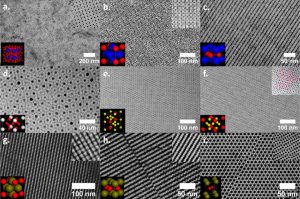Diroll, Jishkariani, Cargnello, Murray (University of Pennsylvania), Donnio (CNRS)

IRG-4 creates new forms of matter by assembling nanometer-sized crystals into large, ordered, complex assemblies (nanocrystal superlattices.
Murray (IRG-4) and Donnio (CNRS) have synthesized a library of molecules (polycatenars) that enable new kinds of nanocrystals and superlattices.
Diroll, Jishkariani, Cargnello, Murray, Donnio, J. Am. Chem. Soc. 2016,138, 10508-10515.
Technical note: These superlattices involve assembly of two different kinds of nanocrystals (thus, binary superlattices), and many shown include two different kinds of ligands. These new ligands are enabling synthesis of metallic, chalcogenide, pnictide, oxide and rare-earth nanocrystals, greatly expanding the “periodic table” of nanocrystals that one can draw from. Additionally, the ligands are able to tune the NC-NC interaction from hard sphere to “soft” sphere, which then changes the superlattice crystal structure.

